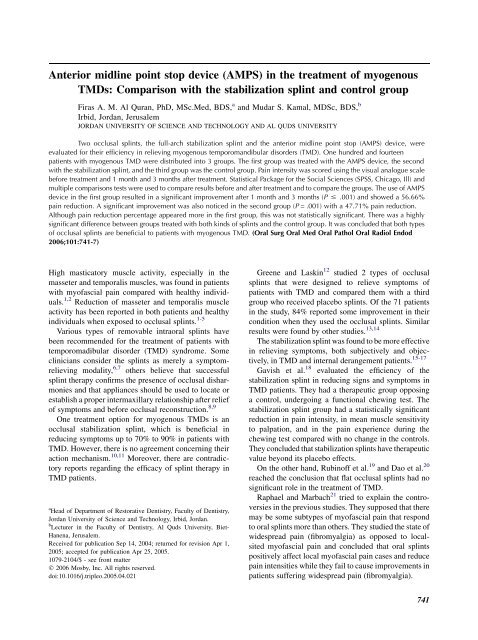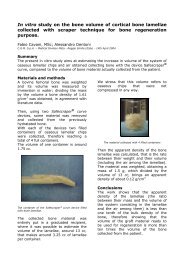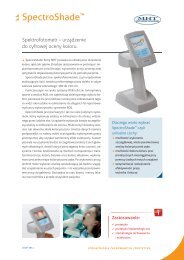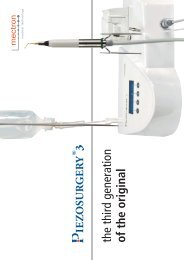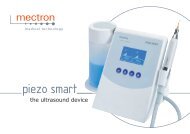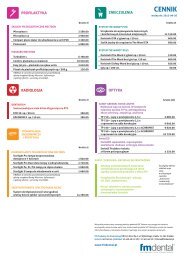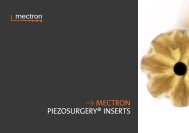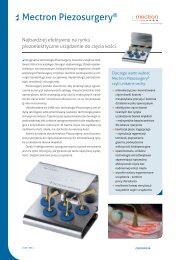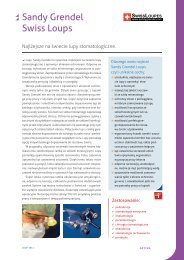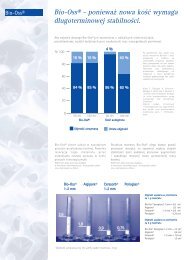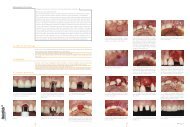Anterior midline point stop device (AMPS) in the treatment of ...
Anterior midline point stop device (AMPS) in the treatment of ...
Anterior midline point stop device (AMPS) in the treatment of ...
You also want an ePaper? Increase the reach of your titles
YUMPU automatically turns print PDFs into web optimized ePapers that Google loves.
<strong>Anterior</strong> <strong>midl<strong>in</strong>e</strong> <strong>po<strong>in</strong>t</strong> <strong>stop</strong> <strong>device</strong> (<strong>AMPS</strong>) <strong>in</strong> <strong>the</strong> <strong>treatment</strong> <strong>of</strong> myogenous<br />
TMDs: Comparison with <strong>the</strong> stabilization spl<strong>in</strong>t and control group<br />
FirasA.M.AlQuran,PhD,MSc.Med,BDS, a and Mudar S. Kamal, MDSc, BDS, b<br />
Irbid, Jordan, Jerusalem<br />
JORDAN UNIVERSITY OF SCIENCE AND TECHNOLOGY AND AL QUDS UNIVERSITY<br />
Two occlusal spl<strong>in</strong>ts, <strong>the</strong> full-arch stabilization spl<strong>in</strong>t and <strong>the</strong> anterior <strong>midl<strong>in</strong>e</strong> <strong>po<strong>in</strong>t</strong> <strong>stop</strong> (<strong>AMPS</strong>) <strong>device</strong>, were<br />
evaluated for <strong>the</strong>ir efficiency <strong>in</strong> reliev<strong>in</strong>g myogenous temporomandibular disorders (TMD). One hundred and fourteen<br />
patients with myogenous TMD were distributed <strong>in</strong>to 3 groups. The first group was treated with <strong>the</strong> <strong>AMPS</strong> <strong>device</strong>, <strong>the</strong> second<br />
with <strong>the</strong> stabilization spl<strong>in</strong>t, and <strong>the</strong> third group was <strong>the</strong> control group. Pa<strong>in</strong> <strong>in</strong>tensity was scored us<strong>in</strong>g <strong>the</strong> visual analogue scale<br />
before <strong>treatment</strong> and 1 month and 3 months after <strong>treatment</strong>. Statistical Package for <strong>the</strong> Social Sciences (SPSS, Chicago, Ill) and<br />
multiple comparisons tests were used to compare results before and after <strong>treatment</strong> and to compare <strong>the</strong> groups. The use <strong>of</strong> <strong>AMPS</strong><br />
<strong>device</strong> <strong>in</strong> <strong>the</strong> first group resulted <strong>in</strong> a significant improvement after 1 month and 3 months (P # .001) and showed a 56.66%<br />
pa<strong>in</strong> reduction. A significant improvement was also noticed <strong>in</strong> <strong>the</strong> second group (P = .001) with a 47.71% pa<strong>in</strong> reduction.<br />
Although pa<strong>in</strong> reduction percentage appeared more <strong>in</strong> <strong>the</strong> first group, this was not statistically significant. There was a highly<br />
significant difference between groups treated with both k<strong>in</strong>ds <strong>of</strong> spl<strong>in</strong>ts and <strong>the</strong> control group. It was concluded that both types<br />
<strong>of</strong> occlusal spl<strong>in</strong>ts are beneficial to patients with myogenous TMD. (Oral Surg Oral Med Oral Pathol Oral Radiol Endod<br />
2006;101:741-7)<br />
High masticatory muscle activity, especially <strong>in</strong> <strong>the</strong><br />
masseter and temporalis muscles, was found <strong>in</strong> patients<br />
with my<strong>of</strong>ascial pa<strong>in</strong> compared with healthy <strong>in</strong>dividuals.<br />
1,2 Reduction <strong>of</strong> masseter and temporalis muscle<br />
activity has been reported <strong>in</strong> both patients and healthy<br />
<strong>in</strong>dividuals when exposed to occlusal spl<strong>in</strong>ts. 1-5<br />
Various types <strong>of</strong> removable <strong>in</strong>traoral spl<strong>in</strong>ts have<br />
been recommended for <strong>the</strong> <strong>treatment</strong> <strong>of</strong> patients with<br />
temporomadibular disorder (TMD) syndrome. Some<br />
cl<strong>in</strong>icians consider <strong>the</strong> spl<strong>in</strong>ts as merely a symptomreliev<strong>in</strong>g<br />
modality, 6,7 o<strong>the</strong>rs believe that successful<br />
spl<strong>in</strong>t <strong>the</strong>rapy confirms <strong>the</strong> presence <strong>of</strong> occlusal disharmonies<br />
and that appliances should be used to locate or<br />
establish a proper <strong>in</strong>termaxillary relationship after relief<br />
<strong>of</strong> symptoms and before occlusal reconstruction. 8,9<br />
One <strong>treatment</strong> option for myogenous TMDs is an<br />
occlusal stabilization spl<strong>in</strong>t, which is beneficial <strong>in</strong><br />
reduc<strong>in</strong>g symptoms up to 70% to 90% <strong>in</strong> patients with<br />
TMD. However, <strong>the</strong>re is no agreement concern<strong>in</strong>g <strong>the</strong>ir<br />
action mechanism. 10,11 Moreover, <strong>the</strong>re are contradictory<br />
reports regard<strong>in</strong>g <strong>the</strong> efficacy <strong>of</strong> spl<strong>in</strong>t <strong>the</strong>rapy <strong>in</strong><br />
TMD patients.<br />
a Head <strong>of</strong> Department <strong>of</strong> Restorative Dentistry, Faculty <strong>of</strong> Dentistry,<br />
Jordan University <strong>of</strong> Science and Technology, Irbid, Jordan.<br />
b Lecturer <strong>in</strong> <strong>the</strong> Faculty <strong>of</strong> Dentistry, Al Quds University, Biet-<br />
Hanena, Jerusalem.<br />
Received for publication Sep 14, 2004; returned for revision Apr 1,<br />
2005; accepted for publication Apr 25, 2005.<br />
1079-2104/$ - see front matter<br />
Ó 2006 Mosby, Inc. All rights reserved.<br />
doi:10.1016/j.tripleo.2005.04.021<br />
Greene and Lask<strong>in</strong> 12 studied 2 types <strong>of</strong> occlusal<br />
spl<strong>in</strong>ts that were designed to relieve symptoms <strong>of</strong><br />
patients with TMD and compared <strong>the</strong>m with a third<br />
group who received placebo spl<strong>in</strong>ts. Of <strong>the</strong> 71 patients<br />
<strong>in</strong> <strong>the</strong> study, 84% reported some improvement <strong>in</strong> <strong>the</strong>ir<br />
condition when <strong>the</strong>y used <strong>the</strong> occlusal spl<strong>in</strong>ts. Similar<br />
results were found by o<strong>the</strong>r studies. 13,14<br />
The stabilization spl<strong>in</strong>t was found to be more effective<br />
<strong>in</strong> reliev<strong>in</strong>g symptoms, both subjectively and objectively,<br />
<strong>in</strong> TMD and <strong>in</strong>ternal derangement patients. 15-17<br />
Gavish et al. 18 evaluated <strong>the</strong> efficiency <strong>of</strong> <strong>the</strong><br />
stabilization spl<strong>in</strong>t <strong>in</strong> reduc<strong>in</strong>g signs and symptoms <strong>in</strong><br />
TMD patients. They had a <strong>the</strong>rapeutic group oppos<strong>in</strong>g<br />
a control, undergo<strong>in</strong>g a functional chew<strong>in</strong>g test. The<br />
stabilization spl<strong>in</strong>t group had a statistically significant<br />
reduction <strong>in</strong> pa<strong>in</strong> <strong>in</strong>tensity, <strong>in</strong> mean muscle sensitivity<br />
to palpation, and <strong>in</strong> <strong>the</strong> pa<strong>in</strong> experience dur<strong>in</strong>g <strong>the</strong><br />
chew<strong>in</strong>g test compared with no change <strong>in</strong> <strong>the</strong> controls.<br />
They concluded that stabilization spl<strong>in</strong>ts have <strong>the</strong>rapeutic<br />
value beyond its placebo effects.<br />
On <strong>the</strong> o<strong>the</strong>r hand, Rub<strong>in</strong><strong>of</strong>f et al. 19 and Dao et al. 20<br />
reached <strong>the</strong> conclusion that flat occlusal spl<strong>in</strong>ts had no<br />
significant role <strong>in</strong> <strong>the</strong> <strong>treatment</strong> <strong>of</strong> TMD.<br />
Raphael and Marbach 21 tried to expla<strong>in</strong> <strong>the</strong> controversies<br />
<strong>in</strong> <strong>the</strong> previous studies. They supposed that <strong>the</strong>re<br />
may be some subtypes <strong>of</strong> my<strong>of</strong>ascial pa<strong>in</strong> that respond<br />
to oral spl<strong>in</strong>ts more than o<strong>the</strong>rs. They studied <strong>the</strong> state <strong>of</strong><br />
widespread pa<strong>in</strong> (fibromyalgia) as opposed to localsited<br />
my<strong>of</strong>ascial pa<strong>in</strong> and concluded that oral spl<strong>in</strong>ts<br />
positively affect local my<strong>of</strong>ascial pa<strong>in</strong> cases and reduce<br />
pa<strong>in</strong> <strong>in</strong>tensities while <strong>the</strong>y fail to cause improvements <strong>in</strong><br />
patients suffer<strong>in</strong>g widespread pa<strong>in</strong> (fibromyalgia).<br />
741
OOOOE<br />
742 Al Quran and Kamal June 2006<br />
Fig. 1. A, The stabilization spl<strong>in</strong>t with centric <strong>stop</strong>s <strong>in</strong> blue.<br />
Even contact between <strong>the</strong> spl<strong>in</strong>t and all oppos<strong>in</strong>g teeth <strong>in</strong> <strong>the</strong><br />
centric relation jaw position is achieved. B, The red V-shaped<br />
mark <strong>in</strong>dicates that ideal anterior guidance is provided.<br />
Great attention has been given to <strong>the</strong> full-arch<br />
stabilization spl<strong>in</strong>t, which proved to be a successful<br />
option <strong>in</strong> many studies. 15-18 Therefore, as <strong>in</strong> any o<strong>the</strong>r<br />
<strong>treatment</strong> modality, disadvantages were encourag<strong>in</strong>g<br />
fur<strong>the</strong>r <strong>in</strong>vestigations lead<strong>in</strong>g to design modifications.<br />
It is presumed that <strong>the</strong> anterior <strong>midl<strong>in</strong>e</strong> <strong>po<strong>in</strong>t</strong> <strong>stop</strong><br />
(<strong>AMPS</strong>) <strong>device</strong> is a spl<strong>in</strong>t that takes advantage <strong>of</strong> <strong>the</strong><br />
jaw-open<strong>in</strong>g reflex by stimulat<strong>in</strong>g <strong>the</strong> nociceptive<br />
trigem<strong>in</strong>al <strong>in</strong>hibition receptors at <strong>the</strong> lower anterior<br />
teeth periodontal ligament, which <strong>in</strong> turn signals <strong>the</strong><br />
trigem<strong>in</strong>al nerve to <strong>in</strong>hibit elevator muscle contractions.<br />
This k<strong>in</strong>d <strong>of</strong> spl<strong>in</strong>t is becom<strong>in</strong>g a widely used <strong>treatment</strong><br />
option <strong>in</strong> <strong>the</strong> United States with little if any studies to<br />
support its use. 22 This study aims to evaluate <strong>the</strong><br />
efficiency <strong>of</strong> 2 occlusal spl<strong>in</strong>ts (<strong>AMPS</strong>, stabilization<br />
spl<strong>in</strong>t) <strong>in</strong> reliev<strong>in</strong>g myogenous TMDs and compare <strong>the</strong><br />
2 appliances <strong>in</strong> reliev<strong>in</strong>g symptoms.<br />
MATERIALS AND METHODS<br />
This study <strong>in</strong>volved 114 patients with myogenous<br />
TMDs. These patients were selected randomly from<br />
diagnosed cases at <strong>the</strong> Jordan University <strong>of</strong> Science and<br />
Technology Health Center. Every patient had at least<br />
1 symptom, such as masticatory muscle pa<strong>in</strong>, limitation,<br />
deviation, or tenderness that characterizes <strong>the</strong> myogenous<br />
TMD, and excluded any patient with articular<br />
problems. All subjects had class 1 <strong>in</strong>cisal relationships<br />
and did not use any dental pros<strong>the</strong>sis.<br />
Diagnosis was done by <strong>the</strong> basic chair-side exam<strong>in</strong>ation<br />
procedure. Severity <strong>of</strong> pa<strong>in</strong> before and after<br />
<strong>treatment</strong> was measured us<strong>in</strong>g visual or l<strong>in</strong>ear analogue<br />
scale (VAS).<br />
The patients were divided <strong>in</strong>to 3 groups <strong>of</strong> 38 patients<br />
each. The first received <strong>the</strong> <strong>AMPS</strong> <strong>device</strong>, <strong>the</strong> second<br />
group received <strong>the</strong> full-arch maxillary occlusal spl<strong>in</strong>t<br />
(SS), and <strong>the</strong> third constituted <strong>the</strong> control group.<br />
<strong>AMPS</strong> and SS appliances were constructed <strong>in</strong> <strong>the</strong><br />
dental school laboratory us<strong>in</strong>g clear heat cure acrylic<br />
res<strong>in</strong> (Meliodent, Heraeus Kulzer, Wehrheim, Germany)<br />
and were modified at <strong>the</strong> chair side for occlusal needs<br />
or rel<strong>in</strong><strong>in</strong>g. Patients were <strong>in</strong>structed not to use any type<br />
<strong>of</strong> <strong>the</strong>rapeutic drugs (eg, tranquilizers, nonsteroidal<br />
anti-<strong>in</strong>flammatory).<br />
The stabilization spl<strong>in</strong>ts were constructed to give<br />
stability <strong>in</strong> <strong>the</strong> patient’s mouth; balanced <strong>in</strong> centric<br />
relation; equal <strong>in</strong>tensity <strong>stop</strong>s on all teeth; immediate<br />
posterior disclusion <strong>in</strong> lateral, protrusive, and extended<br />
lateral excursions (crossover); a ‘‘skat<strong>in</strong>g r<strong>in</strong>k’’ surface;<br />
smooth transitions; comfort dur<strong>in</strong>g wear; and reasonable<br />
es<strong>the</strong>tics (Fig. 1).<br />
At <strong>the</strong> delivery visits, repetitive adjustments <strong>of</strong> <strong>the</strong><br />
spl<strong>in</strong>t were made after mark<strong>in</strong>g <strong>the</strong> occlusal contacts<br />
with th<strong>in</strong> articulat<strong>in</strong>g film until <strong>the</strong> full range <strong>of</strong> centric<br />
<strong>stop</strong>s were achieved. Patients were <strong>in</strong>structed to use <strong>the</strong><br />
spl<strong>in</strong>ts only at night.<br />
Patients were reviewed on weekly basis to ensure that<br />
spl<strong>in</strong>ts were <strong>in</strong> <strong>the</strong> correct shape, but assessments were<br />
taken on <strong>the</strong> VAS only 1 month and 3 months after<br />
deliver<strong>in</strong>g <strong>the</strong> spl<strong>in</strong>ts.<br />
The <strong>AMPS</strong> <strong>device</strong> covers <strong>the</strong> upper central <strong>in</strong>cisors<br />
and allows for a <strong>po<strong>in</strong>t</strong> <strong>stop</strong> (disclud<strong>in</strong>g element), typically<br />
perpendicular to <strong>the</strong> long axis <strong>of</strong> lower <strong>in</strong>cisors,<br />
and ideally on <strong>the</strong> mesial <strong>in</strong>cisal edges <strong>of</strong> <strong>the</strong> 2 lower<br />
centrals and discludes <strong>the</strong> posterior teeth (Fig. 2).<br />
The <strong>AMPS</strong> <strong>device</strong>s prevented posterior and can<strong>in</strong>e<br />
occlud<strong>in</strong>g <strong>in</strong> all excursive and protrusive movements.<br />
The <strong>po<strong>in</strong>t</strong> or <strong>the</strong> disclud<strong>in</strong>g elements were ramped antroposteriorly<br />
to provide a smooth path <strong>in</strong> protrusion while<br />
horizontally narrow enough to prevent <strong>the</strong> can<strong>in</strong>es<br />
from touch<strong>in</strong>g it.<br />
The control group received no <strong>treatment</strong> dur<strong>in</strong>g <strong>the</strong><br />
study period, only assurance, and <strong>the</strong>y were told that if
OOOOE<br />
Volume 101, Number 6 Al Quran and Kamal 743<br />
Fig. 2. A, Frontal view show<strong>in</strong>g <strong>the</strong> <strong>AMPS</strong> <strong>device</strong> fitted on <strong>the</strong> 2 upper central <strong>in</strong>cisors. B, The disclud<strong>in</strong>g element <strong>of</strong> <strong>the</strong> <strong>device</strong><br />
touches <strong>the</strong> 2 lower central <strong>in</strong>cisors only by a s<strong>in</strong>gle <strong>po<strong>in</strong>t</strong>.<br />
<strong>the</strong>y weren’t improved at <strong>the</strong> end <strong>of</strong> <strong>the</strong> study <strong>the</strong>y would<br />
receive appliances free <strong>of</strong> charge.<br />
Patients scored pa<strong>in</strong> severity on <strong>the</strong> VAS after 1 month<br />
and 3 months. Signs and symptoms were recorded at<br />
every follow-up visit us<strong>in</strong>g <strong>the</strong> VAS, and patients were<br />
asked to state any discomfort and comment on any<br />
advantages and disadvantages. Appliances were adjusted<br />
at every visit for any occlusal <strong>in</strong>terference.<br />
Results were analyzed <strong>in</strong> <strong>the</strong> computer us<strong>in</strong>g <strong>the</strong><br />
Statistical Package for <strong>the</strong> Social Sciences (SPSS,<br />
Chicago Ill), and multiple comparison tests were used<br />
to compare results before and after <strong>treatment</strong> and to<br />
compare <strong>the</strong> groups.<br />
RESULTS<br />
One hundred and fourteen patients with myogenous<br />
TMD were <strong>in</strong>volved <strong>in</strong> this study, 49 (43%) were males<br />
and 65 (57%) were females. The mean age for all<br />
patients <strong>in</strong> all groups was 33.5 years, rang<strong>in</strong>g from 15 to<br />
62 years old. The mean age for <strong>the</strong> first group (<strong>AMPS</strong>)<br />
was 32.7, <strong>the</strong> second group (SS) was 31.8 years, and 36<br />
years for <strong>the</strong> control group. There were no significant<br />
age differences with<strong>in</strong> <strong>the</strong> groups.<br />
The pre<strong>treatment</strong> pa<strong>in</strong> severity scores obta<strong>in</strong>ed from<br />
<strong>the</strong> VAS are shown <strong>in</strong> Table I. Before <strong>treatment</strong>, <strong>the</strong> VAS<br />
scor<strong>in</strong>g for <strong>the</strong> first group (<strong>AMPS</strong>) ranged from 2.5 to<br />
9.6 with a mean <strong>of</strong> 6.29. After 1 month <strong>of</strong> <strong>treatment</strong>
OOOOE<br />
744 Al Quran and Kamal June 2006<br />
Table I. Severity <strong>of</strong> pa<strong>in</strong> scored by VAS scale and amount <strong>of</strong> pa<strong>in</strong> reduction before and after <strong>treatment</strong> for <strong>the</strong><br />
3 groups<br />
Device<br />
<strong>AMPS</strong> (group 1)<br />
n M<strong>in</strong>imum Maximum Mean SD<br />
Before Treatment 38 2.50 9.60 6.29 1.88<br />
1 month after <strong>treatment</strong> 38 0.80 7.00 3.65 1.60<br />
3 months after <strong>treatment</strong> 38 0.30 6.80 2.62 1.80<br />
Pa<strong>in</strong> reduction after 1 month 38 ÿ5.60 0.70 ÿ2.64 1.72<br />
Pa<strong>in</strong> reduction after 3 months<br />
SS (group 2)<br />
38 ÿ7.50 0.30 ÿ3.67 2.13<br />
Before <strong>treatment</strong> 38 2.60 9.50 6.32 1.57<br />
1 month after <strong>treatment</strong> 38 0.40 7.30 4.12 1.73<br />
3 months after <strong>treatment</strong> 38 0.00 7.00 3.2 1.73<br />
Pa<strong>in</strong> reduction after 1 month 38 ÿ7.00 0.70 ÿ2.19 1.98<br />
Pa<strong>in</strong> reduction after 3 months<br />
Control (group3)<br />
38 ÿ9.50 0.30 ÿ3.12 2.21<br />
Before <strong>treatment</strong> 38 4.60 8.70 6.35 1.34<br />
1 month after <strong>treatment</strong> 38 3.80 8.50 6.12 1.38<br />
3 months after <strong>treatment</strong> 38 3.80 8.30 5.71 1.23<br />
Pa<strong>in</strong> reduction after 1 month 38 ÿ2.60 1.20 ÿ0.17 0.88<br />
Pa<strong>in</strong> reduction after 3 months 38 ÿ3.50 2.00 ÿ0.59 1.08<br />
<strong>AMPS</strong>, <strong>Anterior</strong> <strong>midl<strong>in</strong>e</strong> <strong>po<strong>in</strong>t</strong> <strong>stop</strong>; SS, stabilization spl<strong>in</strong>t.<br />
Table II. The significance <strong>of</strong> improvement after<br />
1 month and after 3 months for <strong>the</strong> 3 groups<br />
Device t df<br />
Significance<br />
(2-tailed)<br />
<strong>AMPS</strong> after 1 month 9.44 37 .000<br />
After 3 months 10.61 37 .000<br />
SS after 1 month 6.82 37 .000<br />
After 3 months 8.71 37 .000<br />
Control after 1 month 1.39 37 .172<br />
After 3 months 3.16 37 .051<br />
<strong>AMPS</strong>, <strong>Anterior</strong> <strong>midl<strong>in</strong>e</strong> <strong>po<strong>in</strong>t</strong> <strong>stop</strong>; SS, stabilization spl<strong>in</strong>t.<br />
scores ranged from 0.8 to 7.0 giv<strong>in</strong>g a mean <strong>of</strong> 3.65. The<br />
scores’ mean became 2.62 at <strong>the</strong> end <strong>of</strong> <strong>the</strong> third month<br />
and ranged from 0.3 to 6.8.<br />
The second group started with a mean <strong>of</strong> 6.32 and<br />
a range from 2.6 to 9.5. VAS scores recorded after<br />
1 month ranged from 0.4 to 7.3 with a mean 4.12. At<br />
<strong>the</strong> end <strong>of</strong> <strong>the</strong> third month VAS scores ranged from<br />
0 to 7 giv<strong>in</strong>g a mean <strong>of</strong> 3.2 (Table I).<br />
The control group started with mean VAS score<br />
similar to <strong>the</strong> previous groups: 6.35, rang<strong>in</strong>g from 4.6 to<br />
8.3. There was little reduction after 1 month with 6.12<br />
mean and at <strong>the</strong> end <strong>of</strong> <strong>the</strong> third month <strong>the</strong> mean for <strong>the</strong><br />
VAS scores was 5.71.<br />
Percentage <strong>of</strong> pa<strong>in</strong> reduction was calculated by<br />
divid<strong>in</strong>g <strong>the</strong> difference between mean scores at <strong>the</strong><br />
third month and basel<strong>in</strong>e divided by <strong>the</strong> mean score at<br />
basel<strong>in</strong>e (Table I). This calculation revealed a 56.66%<br />
pa<strong>in</strong> reduction for <strong>the</strong> group receiv<strong>in</strong>g <strong>the</strong> <strong>AMPS</strong> <strong>device</strong><br />
(first group) and a 47.71% reduction for <strong>the</strong> group<br />
receiv<strong>in</strong>g <strong>the</strong> SS (second group) with<strong>in</strong> 3 months <strong>of</strong><br />
<strong>treatment</strong>. There was only 13.41% pa<strong>in</strong> reduction <strong>in</strong> <strong>the</strong><br />
control group.<br />
The Student t test compar<strong>in</strong>g <strong>the</strong> 2 means showed that<br />
us<strong>in</strong>g <strong>the</strong> <strong>AMPS</strong> <strong>device</strong> for <strong>the</strong> patients <strong>in</strong> <strong>the</strong> first group<br />
resulted <strong>in</strong> a significant improvement after 1 month and<br />
3 months (P # .001; Table II). A significant improvement<br />
was also noticed after 1 month and 3 months with<br />
patients <strong>in</strong> <strong>the</strong> second group who received <strong>the</strong> SS<br />
(P = .001; Table II). There was no significant improvement<br />
<strong>in</strong> <strong>the</strong> control group (Table II).<br />
Multiple comparisons were carried out to exam<strong>in</strong>e <strong>the</strong><br />
differences <strong>in</strong> <strong>the</strong> pa<strong>in</strong> reduction among <strong>the</strong> 3 groups as<br />
shown <strong>in</strong> Table III. Before any <strong>treatment</strong> <strong>the</strong>re were no<br />
differences at all between <strong>the</strong> 3 groups, with similar<br />
VAS average <strong>in</strong> <strong>the</strong> basel<strong>in</strong>e scores. After <strong>treatment</strong> with<br />
ei<strong>the</strong>r <strong>AMPS</strong> <strong>device</strong> or SS, a highly significant difference<br />
was found <strong>in</strong> both groups when compared to <strong>the</strong><br />
control group (P # .001). Although pa<strong>in</strong> reduction<br />
percentage appeared more <strong>in</strong> <strong>the</strong> group treated with <strong>the</strong><br />
<strong>AMPS</strong> <strong>device</strong>, this was not statistically significant<br />
(P = .55 after 1 month and P = .37 after 3 months) and<br />
both spl<strong>in</strong>ts were not different <strong>in</strong> <strong>the</strong>ir success rate when<br />
tested based on <strong>the</strong>ir marg<strong>in</strong>al means as shown <strong>in</strong> Table<br />
III. Figure 3 shows <strong>the</strong> l<strong>in</strong>ear drop <strong>in</strong> <strong>the</strong> severity <strong>of</strong> pa<strong>in</strong><br />
from pre<strong>treatment</strong> <strong>po<strong>in</strong>t</strong>s until <strong>the</strong> last assessment (after<br />
3 months) for <strong>the</strong> 3 groups. Although more reduction <strong>of</strong><br />
pa<strong>in</strong> appears with <strong>the</strong> <strong>AMPS</strong> <strong>device</strong>, this was statistically<br />
<strong>in</strong>significant.<br />
DISCUSSION<br />
The reduction <strong>of</strong> pa<strong>in</strong>ful symptoms with appliance<br />
<strong>the</strong>rapy has been well documented. Many studies
OOOOE<br />
Volume 101, Number 6 Al Quran and Kamal 745<br />
Table III. P values show<strong>in</strong>g <strong>the</strong> differences between different groups based on estimated marg<strong>in</strong>al means before<br />
<strong>treatment</strong>, 1 month after <strong>treatment</strong>, and 3 months after <strong>treatment</strong><br />
Dependent variable (I) Device (J) Device<br />
Severity <strong>of</strong> pa<strong>in</strong><br />
before <strong>treatment</strong><br />
Severity <strong>of</strong> pa<strong>in</strong><br />
after 1 month<br />
Severity <strong>of</strong> pa<strong>in</strong><br />
after 3 months<br />
<strong>AMPS</strong>, <strong>Anterior</strong> <strong>midl<strong>in</strong>e</strong> <strong>po<strong>in</strong>t</strong> <strong>stop</strong>; SS, stabilization spl<strong>in</strong>t.<br />
*The mean difference is significant at <strong>the</strong> .05 level.<br />
have found resolution <strong>of</strong> symptoms after <strong>in</strong>sertion <strong>of</strong><br />
occlusal appliances. 18,23-27 In this study patients expressed<br />
a significant reduction <strong>of</strong> pa<strong>in</strong> when treated<br />
ei<strong>the</strong>r by <strong>AMPS</strong> or SS <strong>in</strong>terocclusal spl<strong>in</strong>ts (SS, 47.71%<br />
reduction; <strong>AMPS</strong> <strong>device</strong>, 56.66%). The results <strong>of</strong> this<br />
study support that <strong>the</strong> reduction <strong>in</strong> myogenous TMD<br />
pa<strong>in</strong> is due to <strong>the</strong> use <strong>of</strong> ei<strong>the</strong>r <strong>AMPS</strong> or SS and is not<br />
due to o<strong>the</strong>r factors, because when <strong>the</strong>se f<strong>in</strong>d<strong>in</strong>gs were<br />
compared with <strong>the</strong> control group a highly significant<br />
difference was reported (P # .001). These results<br />
support and reproduce previous documentation concern<strong>in</strong>g<br />
<strong>the</strong> SS. 15-17,28,29 The <strong>AMPS</strong> <strong>device</strong>, which<br />
previously received little attention by researchers, was<br />
also shown to be impressively effective by this study.<br />
Most cl<strong>in</strong>icians <strong>in</strong>struct <strong>the</strong>ir patients to use <strong>the</strong>ir<br />
appliances until resolution <strong>of</strong> symptoms is achieved.<br />
This period is followed by a wean<strong>in</strong>g-<strong>of</strong>f period until <strong>the</strong><br />
use <strong>of</strong> <strong>the</strong> appliance is totally discont<strong>in</strong>ued. Patients not<br />
show<strong>in</strong>g any positive response with<strong>in</strong> 3 to 4 weeks are<br />
reevaluated, and fur<strong>the</strong>r <strong>in</strong>vestigations are usually<br />
<strong>in</strong>dicated. 30 No specific overall <strong>treatment</strong> time is agreed<br />
on, but spl<strong>in</strong>t <strong>the</strong>rapy has shown to be effective over<br />
time. 10,27,28<br />
Follow<strong>in</strong>g up <strong>the</strong> 2 groups <strong>of</strong> patients who<br />
received <strong>in</strong>traoral occlusal spl<strong>in</strong>ts <strong>in</strong> this study for 3<br />
months showed that pa<strong>in</strong> reduction was significant after<br />
1 month <strong>of</strong> <strong>treatment</strong>, and this reduction cont<strong>in</strong>ued to be<br />
significant dur<strong>in</strong>g <strong>the</strong> follow<strong>in</strong>g 2 months. It seems that<br />
3 months <strong>of</strong> spl<strong>in</strong>t <strong>the</strong>rapy is satisfactory if it is followed<br />
by periodic evaluation and a sufficient wean<strong>in</strong>g-<strong>of</strong>f<br />
period. From a research <strong>po<strong>in</strong>t</strong> <strong>of</strong> view, 3 months <strong>of</strong><br />
follow-up may be enough to evaluate <strong>the</strong> mood <strong>of</strong><br />
progress done by <strong>the</strong> spl<strong>in</strong>ts. 10 Short-term studies that<br />
report success <strong>of</strong> various <strong>the</strong>rapies need to be questioned<br />
regard<strong>in</strong>g <strong>the</strong>ir actual effect, if <strong>the</strong> fluctuation <strong>of</strong><br />
symptoms associated with chronic pa<strong>in</strong> conditions is<br />
addressed. ‘‘Regression to <strong>the</strong> mean’’ is a statistical term<br />
Mean difference<br />
(I ÿ J) SE Significance<br />
95% Confidence Interval<br />
Lower<br />
bound<br />
Upper<br />
bound<br />
<strong>AMPS</strong> SS ÿ.026 .3708 1.000 ÿ.928 .875<br />
<strong>AMPS</strong> Control ÿ.053 .3708 1.000 ÿ.954 .849<br />
SS Control ÿ.026 .3708 1.000 ÿ.928 .875<br />
<strong>AMPS</strong> SS ÿ.471 .3544 .559 ÿ1.332 .390<br />
<strong>AMPS</strong> Control ÿ2.468* .3544 .000 ÿ3.330 ÿ1.607<br />
SS Control ÿ1.997* .3544 .000 ÿ2.859 ÿ1.136<br />
<strong>AMPS</strong> SS ÿ.571 .3689 .374 ÿ1.468 .326<br />
<strong>AMPS</strong> Control ÿ3.082* .3689 .000 ÿ3.978 ÿ2.185<br />
SS Control ÿ2.511* .3689 .000 ÿ3.407 ÿ1.614<br />
Fig. 3. L<strong>in</strong>ear drop <strong>in</strong> <strong>the</strong> severity <strong>of</strong> pa<strong>in</strong> us<strong>in</strong>g 2 <strong>device</strong>s<br />
(red, <strong>AMPS</strong>; green, stabilization spl<strong>in</strong>t; blue, control group)<br />
throughout <strong>the</strong> <strong>treatment</strong> period.<br />
that addresses this issue. 10 Pa<strong>in</strong> <strong>in</strong>tensity <strong>of</strong>ten varies on<br />
a daily basis. When us<strong>in</strong>g <strong>the</strong> VAS, patients should<br />
report an average <strong>of</strong> <strong>the</strong>ir pa<strong>in</strong>. If patients visit <strong>the</strong> cl<strong>in</strong>ic<br />
when <strong>the</strong> <strong>in</strong>tensity exceeds <strong>the</strong> mean and regression to<br />
<strong>the</strong> average occurs after <strong>the</strong>rapy, <strong>the</strong> cl<strong>in</strong>ician must<br />
question if pa<strong>in</strong> reduction is a result <strong>of</strong> <strong>the</strong>rapy or a<br />
natural regression to <strong>the</strong> mean. Short-term studies lack<br />
<strong>the</strong> ability to differentiate this issue.<br />
The study groups were <strong>in</strong>structed to wear <strong>the</strong>ir spl<strong>in</strong>ts<br />
only at night. This appeared to be effective s<strong>in</strong>ce<br />
reduction <strong>of</strong> symptoms was significantly recorded.<br />
Wilk<strong>in</strong>son et al. 31 suggested that nocturnal use <strong>of</strong><br />
occlusal spl<strong>in</strong>t only was more successful <strong>in</strong> patients with<br />
muscle disorders, whereas patients with articular disorders<br />
benefited from cont<strong>in</strong>uous occlusal spl<strong>in</strong>t. This<br />
agrees with our f<strong>in</strong>d<strong>in</strong>gs s<strong>in</strong>ce we are deal<strong>in</strong>g with<br />
patients with my<strong>of</strong>ascial pa<strong>in</strong> and excluded any patient<br />
with articular problems.
OOOOE<br />
746 Al Quran and Kamal June 2006<br />
The unified concept <strong>of</strong> TMD etiology (1 cause,<br />
1 disease) has been questioned, and <strong>the</strong> trend has shifted<br />
to accept <strong>the</strong> more applicable multifactorial etiology<br />
concept. 27 One <strong>of</strong> <strong>the</strong> implications <strong>of</strong> this concept is that<br />
it helps to expla<strong>in</strong> <strong>the</strong> diversity <strong>of</strong> school <strong>of</strong> thought<br />
regard<strong>in</strong>g <strong>in</strong>terocclusal appliance designs, where each<br />
design is aimed to deal with a specific expected<br />
etiological factor. Despite <strong>the</strong>se various designs, all<br />
spl<strong>in</strong>ts have common features that may expla<strong>in</strong> why<br />
occlusal appliances reduce symptoms. They all alter<br />
occlusal conditions and condylar positions, <strong>in</strong>crease <strong>the</strong><br />
vertical dimension, <strong>in</strong>crease peripheral <strong>in</strong>put to <strong>the</strong><br />
central nervous system, and have a cognitive awareness<br />
and a placebo effect.<br />
Cl<strong>in</strong>icians have not agreed on an optimal spl<strong>in</strong>t design<br />
that could be considered superior over <strong>the</strong> o<strong>the</strong>rs. 18,27<br />
A good reputation has accompanied <strong>the</strong> SS despite its<br />
disadvantages. Great enthusiasm has <strong>in</strong>troduced <strong>the</strong><br />
<strong>AMPS</strong> <strong>device</strong> as a simple, comfortable, easily constructed,<br />
and, most important, very effective spl<strong>in</strong>t.<br />
Patient cooperation is one <strong>of</strong> most important factors on<br />
which <strong>the</strong> success or failure <strong>of</strong> occlusal appliance<br />
<strong>the</strong>rapy depends. 10 Patients who do not respond favorably<br />
to this <strong>the</strong>rapy should be questioned regard<strong>in</strong>g <strong>the</strong>ir<br />
compliance with <strong>the</strong> prescribed use <strong>of</strong> <strong>the</strong> appliance.<br />
Therefore, this was ensured when compar<strong>in</strong>g <strong>the</strong> SS<br />
with <strong>the</strong> <strong>AMPS</strong> <strong>device</strong> <strong>in</strong> <strong>the</strong> present study. It was<br />
clear while <strong>in</strong>terview<strong>in</strong>g <strong>the</strong> patients that <strong>the</strong>y f<strong>in</strong>d <strong>the</strong><br />
<strong>AMPS</strong> easy to use and comfortable, while <strong>the</strong> bulk<strong>in</strong>ess<br />
<strong>of</strong> <strong>the</strong> SS has led to some compla<strong>in</strong>ts <strong>in</strong> <strong>the</strong> second<br />
group us<strong>in</strong>g it. Cont<strong>in</strong>uous encouragement was needed<br />
to ensure compliance. In our op<strong>in</strong>ion this could be a very<br />
important advantage <strong>of</strong> <strong>the</strong> <strong>AMPS</strong> over <strong>the</strong> SS s<strong>in</strong>ce<br />
better cooperation can be ga<strong>in</strong>ed with <strong>the</strong> <strong>device</strong>.<br />
On <strong>the</strong> o<strong>the</strong>r hand, some <strong>of</strong> <strong>the</strong> patients who used <strong>the</strong><br />
<strong>AMPS</strong> <strong>device</strong> compla<strong>in</strong>ed <strong>of</strong> slight soreness <strong>in</strong> <strong>the</strong> upper<br />
anterior teeth at <strong>the</strong> beg<strong>in</strong>n<strong>in</strong>g and it goes away as <strong>the</strong>y<br />
cont<strong>in</strong>ue us<strong>in</strong>g it. A few patients experienced a sort <strong>of</strong><br />
disorientation that <strong>the</strong>ir bite became quite strange and it<br />
took <strong>the</strong>m a short time to f<strong>in</strong>d <strong>the</strong>ir correct bite. It seems<br />
that <strong>the</strong> <strong>AMPS</strong> causes a k<strong>in</strong>d <strong>of</strong> deprogramm<strong>in</strong>g to <strong>the</strong><br />
muscles <strong>of</strong> mastication similar to what has been reported<br />
by o<strong>the</strong>r k<strong>in</strong>ds <strong>of</strong> spl<strong>in</strong>ts. 10 Movements <strong>in</strong> <strong>the</strong> teeth or<br />
changes <strong>in</strong> <strong>the</strong> occlusion have not been <strong>in</strong> any <strong>of</strong> <strong>the</strong><br />
patients who used both spl<strong>in</strong>ts and this supports <strong>the</strong><br />
f<strong>in</strong>d<strong>in</strong>gs <strong>of</strong> K<strong>in</strong>oshita et al. 32 that for posterior teeth to<br />
super erupt it must go unopposed without any contact<br />
for at least 8 days. Therefore, s<strong>in</strong>ce <strong>AMPS</strong> or any o<strong>the</strong>r<br />
removable spl<strong>in</strong>t must be removed whenever <strong>the</strong><br />
patients eat, <strong>the</strong> daily masticatory stimulation <strong>of</strong> <strong>the</strong><br />
molars prevents <strong>the</strong>ir super eruption.<br />
It is apparent from Fig. 1 that, although <strong>the</strong> tendency<br />
was for a better pa<strong>in</strong> reduction <strong>in</strong> patients treated with<br />
<strong>the</strong> <strong>AMPS</strong> when compared with SS, <strong>the</strong> difference was<br />
not statistically significant; ie, both types <strong>of</strong> occlusal<br />
<strong>device</strong>s used <strong>in</strong> this study resulted <strong>in</strong> an improvement<br />
with<strong>in</strong> <strong>the</strong> same time duration with no statistically<br />
significant difference. Although <strong>the</strong> 2 spl<strong>in</strong>ts appear, <strong>in</strong><br />
some respects, to be opposed <strong>in</strong> both objective and mood<br />
<strong>of</strong> action, this may not be applicable to all aspects. Both<br />
could <strong>in</strong>duce changes <strong>in</strong> <strong>the</strong> cognitive awareness and<br />
result <strong>in</strong> behavioral modification <strong>of</strong> <strong>the</strong> patients. 10,14<br />
More importantly, both remove <strong>the</strong> possibility <strong>of</strong> <strong>the</strong><br />
patient occlud<strong>in</strong>g <strong>in</strong> <strong>the</strong>ir habitual bite. F<strong>in</strong>ally, although<br />
<strong>the</strong> SS removes posterior <strong>in</strong>terferences by design, <strong>the</strong><br />
<strong>AMPS</strong> <strong>device</strong> may do <strong>the</strong> same by accident.<br />
As Greene and Lask<strong>in</strong> 33 <strong>po<strong>in</strong>t</strong>ed out <strong>in</strong> 1972, it is<br />
important to note at this <strong>po<strong>in</strong>t</strong> that <strong>the</strong> preoccupation<br />
with <strong>the</strong> mechanical dynamics <strong>of</strong> spl<strong>in</strong>ts unfortunately<br />
has caused most <strong>in</strong>vestigators to overlook <strong>the</strong> potential<br />
psychological effects <strong>of</strong> <strong>the</strong>se appliances. The comb<strong>in</strong>ation<br />
<strong>of</strong> physical and psychological effects produced<br />
by spl<strong>in</strong>ts will contribute significantly to <strong>the</strong>ir cl<strong>in</strong>ical<br />
success. Thus any hypo<strong>the</strong>ses about <strong>the</strong> mechanisms <strong>of</strong><br />
spl<strong>in</strong>t <strong>the</strong>rapy for my<strong>of</strong>ascial pa<strong>in</strong> dysfunction problems<br />
that is based solely on <strong>the</strong> effects <strong>of</strong> <strong>the</strong> occlusal<br />
platform, or that considers only changes <strong>in</strong> <strong>the</strong> vertical<br />
or horizontal placement <strong>of</strong> <strong>the</strong> mandible, is necessarily<br />
<strong>in</strong>complete.<br />
CONCLUSIONS<br />
The use <strong>of</strong> occlusal SS and <strong>AMPS</strong> <strong>device</strong> has<br />
significantly reduced <strong>the</strong> pa<strong>in</strong> <strong>in</strong>tensity <strong>in</strong> patients<br />
suffer<strong>in</strong>g from myogenous TMD. In this study <strong>the</strong>re<br />
was no significant difference between <strong>the</strong> <strong>AMPS</strong> <strong>device</strong><br />
and <strong>the</strong> SS regard<strong>in</strong>g <strong>the</strong>ir success rate, but patients were<br />
more cooperative while deal<strong>in</strong>g with <strong>the</strong> <strong>AMPS</strong> <strong>device</strong>.<br />
The use <strong>of</strong> <strong>the</strong> VAS was very useful and easy to use <strong>in</strong><br />
record<strong>in</strong>g <strong>the</strong> <strong>in</strong>tensity <strong>of</strong> my<strong>of</strong>ascial pa<strong>in</strong>.<br />
REFERENCES<br />
1. Visser A, McCarroll RS, Naeije M. Masticatory muscle activity<br />
<strong>in</strong> different jaw relationships dur<strong>in</strong>g submaximal clench<strong>in</strong>g<br />
efforts. J Dent Res 1992;71:372-9.<br />
2. Visser A, Naeije M, Hansson T. The temoral/masseter cocontraction:<br />
an electromyographic and cl<strong>in</strong>ical evaluation <strong>of</strong><br />
short-term stabilization spl<strong>in</strong>t <strong>the</strong>rapy <strong>in</strong> myogenous CMD<br />
patients. J Oral Rehabil 1995;22:387-9.<br />
3. Naeije M, Hansson TL. Short-term effect <strong>of</strong> <strong>the</strong> stabilization<br />
appliance on masticatory muscle activity <strong>in</strong> myogenous<br />
craniomandibular disorder patients. J Craniomandib Disord<br />
1991;5:245-50.<br />
4. Lobbezoo F, van der Glas HW, van Kampen FMC, Bosman F.<br />
The effect <strong>of</strong> an occlusal stabilization spl<strong>in</strong>t and <strong>the</strong> mode <strong>of</strong><br />
visual feedback on <strong>the</strong> activity balance between jaw elevator<br />
muscles dur<strong>in</strong>g isometric contraction. J Dent Res 1993;72:<br />
876-82.<br />
5. Al Quran FA, Lyons MF. The immediate effect <strong>of</strong> hard and s<strong>of</strong>t<br />
spl<strong>in</strong>ts on <strong>the</strong> EMG activity <strong>of</strong> <strong>the</strong> masseter and temporalis<br />
muscles. J Oral Rehabil 1999;26(7):559-63.<br />
6. Goodman P, Green CS, Lask<strong>in</strong> DM. Response to patients with<br />
my<strong>of</strong>ascial pa<strong>in</strong> dysfunction syndrome to mock equilibration.<br />
J Am Dent Assoc 1976;92:755-8.
OOOOE<br />
Volume 101, Number 6 Al Quran and Kamal 747<br />
7. Westl<strong>in</strong>g L. Occlusal <strong>in</strong>terferences <strong>in</strong> retruded contact position<br />
and temporomandibular jo<strong>in</strong>t sounds. J Oral Rehabil 1995;22:<br />
601-6.<br />
8. Perry HT. Muscular changes associated with temporomandibular<br />
jo<strong>in</strong>t dysfunction. J Am Dent Assoc 1957;54:644-53.<br />
9. Dawson PE. Evaluation, diagnosis and <strong>treatment</strong> <strong>of</strong> occlusal<br />
problems. 2nd ed. St Louis: Mosby; 1989. p. 184.<br />
10. Okeson JP. Management <strong>of</strong> temporomandibular disorders and<br />
occlusion. 5th ed. St Louis: Mosby Inc; 1998. p. 367-78.<br />
11. Clark GT. International appliance <strong>the</strong>rapy. In: Mohl ND,<br />
Zarb GA, Carlsson GE, Ragh JD, editors. A textbook <strong>of</strong><br />
occlusion. Chicago: Qu<strong>in</strong>tessence Book; 1988. p. 271.<br />
12. Greene CS, Lask<strong>in</strong> DM. Spl<strong>in</strong>t <strong>the</strong>rapy for <strong>the</strong> my<strong>of</strong>ascial pa<strong>in</strong>dysfunction<br />
(MPD) syndrome: a comparative study. J Am Dent<br />
Assoc 1972;84:624-8.<br />
13. Carraro JJ, Caffesse RG. Effect <strong>of</strong> occlusal spl<strong>in</strong>ts on TMJ<br />
symptomatology. J Pros<strong>the</strong>t Dent 1976;40:563-6.<br />
14. Okeson JP, Kemper JT, Moody PM. A study <strong>of</strong> <strong>the</strong> use <strong>of</strong> occlusion<br />
spl<strong>in</strong>ts <strong>in</strong> <strong>the</strong> <strong>treatment</strong> <strong>of</strong> acute and chronic patients with<br />
craniomandibular disorders. J Pros<strong>the</strong>t Dent 1982;48:708-12.<br />
15. Johansson A, Wenneberg B, Wagersten C, Haraldson T.<br />
Acupuncture <strong>in</strong> <strong>treatment</strong> <strong>of</strong> facial muscular pa<strong>in</strong>. Acta Odontol<br />
Scand 1991;49:153-8.<br />
16. List T, Helkimo M, Andersson S, Carlsson GE. Acupuncture and<br />
occlusal spl<strong>in</strong>t <strong>the</strong>rapy <strong>in</strong> <strong>the</strong> <strong>treatment</strong> <strong>of</strong> craniomandibular<br />
disorders. Swed Dent J 1992;16:125-41.<br />
17. List T, Helkimo M, Andersson S, Carlsson GE. Acupuncture and<br />
occlusal spl<strong>in</strong>t <strong>the</strong>rapy <strong>in</strong> <strong>the</strong> <strong>treatment</strong> <strong>of</strong> craniomandibular<br />
disorders. II. A 1-year follow-up study. Acta Odontol Scand<br />
1992;50:375-85.<br />
18. Gavish A, W<strong>in</strong>ocur E, Ventura YS, Halachmi M, Gazit E. Effect<br />
<strong>of</strong> stabilization spl<strong>in</strong>t <strong>the</strong>rapy on pa<strong>in</strong> dur<strong>in</strong>g chew<strong>in</strong>g <strong>in</strong> patients<br />
suffer<strong>in</strong>g from my<strong>of</strong>ascial pa<strong>in</strong>. J Oral Rehabil 2002;29:1181-6.<br />
19. Rub<strong>in</strong><strong>of</strong>f MS, Groos A, McCall WD. Conventional and nonocclud<strong>in</strong>g<br />
spl<strong>in</strong>t <strong>the</strong>rapy compared for patients with my<strong>of</strong>ascial<br />
pa<strong>in</strong> dysfunction syndrome. Gen Dent 1987;35:502-6.<br />
20. Dao TT, Lavigne GJ, Charbonneau A, Fe<strong>in</strong>e JS, Lund JP. The<br />
efficacy <strong>of</strong> oral spl<strong>in</strong>t <strong>in</strong> <strong>the</strong> <strong>treatment</strong> <strong>of</strong> my<strong>of</strong>ascial pa<strong>in</strong> <strong>of</strong> <strong>the</strong><br />
jaw muscles: a controlled Cl<strong>in</strong>ical trail. Pa<strong>in</strong> 1994;56:85-94.<br />
21. Raphael KG, Marbach JJ. Widespread pa<strong>in</strong> and <strong>the</strong> effectiveness<br />
<strong>of</strong> oral spl<strong>in</strong>ts <strong>in</strong> my<strong>of</strong>ascial face pa<strong>in</strong>. J Am Dent Assoc 2001;<br />
132:305-16.<br />
22. Boyd JP, Shankland W, Brown C, Schames J. Tam<strong>in</strong>g <strong>the</strong> mascular<br />
forces that threaten everyday dentistry. A special repr<strong>in</strong>t <strong>of</strong> <strong>the</strong><br />
November 2000 peer-reviewed Postgraduate Dentistry.<br />
23. Manns A, Miralles R, Guerrero F. Changes <strong>in</strong> electrical activity<br />
<strong>of</strong> <strong>the</strong> postural muscles <strong>of</strong> <strong>the</strong> mandible upon vary<strong>in</strong>g <strong>the</strong> vertical<br />
dimension. J Pros<strong>the</strong>t Dent 1981;45:438-45.<br />
24. Clark GT, Adler RC. A critical evaluation <strong>of</strong> occlusal <strong>the</strong>rapy:<br />
occlusal adjustment procedures. J Am Dent Assoc 1985;110:<br />
743-50.<br />
25. Sheikholeslam A, Holmgren K, Riise C. A cl<strong>in</strong>ical and<br />
electromyographic study <strong>of</strong> <strong>the</strong> long-term effects <strong>of</strong> an occlusal<br />
spl<strong>in</strong>t on <strong>the</strong> temporal and masseter muscles <strong>in</strong> patients with<br />
functional disorders and nocturnal bruxism. J Oral Rehabil 1986;<br />
13:137-45.<br />
26. Manns A, Valdivia, Mirralles R, Pena MC. The effect <strong>of</strong> different<br />
occlusal spl<strong>in</strong>ts on <strong>the</strong> electromyographic activity <strong>of</strong> elevator<br />
muscles. J Gnathol 1988;7:61-73.<br />
27. Al-Saad M, Akeel R. EMG and pa<strong>in</strong> severity evaluation <strong>in</strong><br />
patients with TMD us<strong>in</strong>g two different occlusal <strong>device</strong>s. Int J<br />
Prosth 2001;14:15-20.<br />
28. Lundh H, Westesson PL, Kopp S, Tillstrom B. <strong>Anterior</strong><br />
reposition<strong>in</strong>g spl<strong>in</strong>t <strong>in</strong> <strong>the</strong> <strong>treatment</strong> <strong>of</strong> temporomandibular jo<strong>in</strong>ts<br />
with reciprocal click<strong>in</strong>g: comparison with a flat occlusal spl<strong>in</strong>t<br />
and an untreated control group. Oral Surg Oral Med Oral Pathol<br />
1985;60(2):131-6.<br />
29. Lund JP, Widmer CG. Evaluation <strong>of</strong> <strong>the</strong> use <strong>of</strong> surface<br />
electromyography <strong>in</strong> <strong>the</strong> diagnosis, documentation, and <strong>treatment</strong><br />
<strong>of</strong> dental patients. J Craniomandib Disord 1989;3:125-37.<br />
30. McNeill C, editor. American Academy <strong>of</strong> Or<strong>of</strong>acial Pa<strong>in</strong>.<br />
Temporomandibular disorders: guidel<strong>in</strong>es for classification,<br />
assessment, and management. 2nd ed. Chicago: Qu<strong>in</strong>tessence<br />
Publish<strong>in</strong>g Co, Inc; 1993.<br />
31. Wilk<strong>in</strong>son T, Hansson TL, McNeill C, Marcel T. A comparison<br />
<strong>of</strong> <strong>the</strong> success <strong>of</strong> 24-hour occlusal spl<strong>in</strong>t <strong>the</strong>rapy versus nocturnal<br />
occlusal spl<strong>in</strong>t <strong>the</strong>rapy <strong>in</strong> reduc<strong>in</strong>g craniomandibular disorders.<br />
J Craniomandib Disord 1992;6:64-70.<br />
32. K<strong>in</strong>oshita Y, Tonooka K, Chiba M. The effect <strong>of</strong> hyp<strong>of</strong>unction on<br />
<strong>the</strong> mechanical properties <strong>of</strong> <strong>the</strong> periodontium <strong>in</strong> <strong>the</strong> rat<br />
mandibular first molar. Arch Oral Biol 1982;27(10):881-5.<br />
33. Greene CS, Lask<strong>in</strong> DM. long-term evaluation <strong>of</strong> conservative<br />
<strong>treatment</strong> for my<strong>of</strong>ascial pa<strong>in</strong> dysfunction syndrome. J Am Dent<br />
Assoc 1974;89(6):1365-8.<br />
Repr<strong>in</strong>t requests:<br />
Firas A. M. Al Quran, PhD, Msc.Med, BDS<br />
Jordan University <strong>of</strong> Science and Technology<br />
Restorative Dentistry<br />
PO Box 3030<br />
IRBID 22110 Irbid<br />
Jordan<br />
firasquran@hotmail.com


